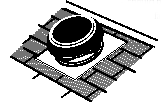|
Should There Be An
Exhaust Fan?
If a roof has a full-length ridge vent at its peak plus vents
in the gables and soffits, is an exhaust
fan necessary? Most attics can be ventilated without powered fans
if a ridge vent and
soffit vents are present. Combined with the common gable vents,
these vents will provide
excellent protection against heat buildup, attic condensation and
mildew.
An attic with an insulated floor and vapor barrier should have
open vent space equal to 1/300
of the attic floor area. "Open" refers to space not
taken up by metal louvers or other
barriers in the vent. It’s best to add a few extra square feet
of vents.
The vapor barrier – an impermeable material, such as craft
paper, foil or plastic sheeting –
should be placed  under
the insulation of the attic floor, facing
the living area. If no vapor barrier is present, the
calculation for open space should be doubled. under
the insulation of the attic floor, facing
the living area. If no vapor barrier is present, the
calculation for open space should be doubled.
A homeowner should make sure that the floor of the
attic is well-insulated without blocking free air movement
through any of the soffit vents. The insulation
will reduce heat loss from
the living area in the winter and
will eliminate any radiator effect to the living area caused by
attic-heat build-up.
How can a homeowner tell if he has sufficient vent space in his
attic? Check the attic in the
winter. If signs of moisture condensation are present, an
improvement of ventilation is
called for. Frost on the points of roofing nails and wet
insulation are both indicators of
moisture condensation.
|
Continued
from previous page.
replace the broken ones. Larger leaks need
to be addressed by a professional or a
very handy homeowner. For
proper drainage, gutters should be pitched
about 1/16 inch per running foot. This
is not an easy measurement to make. Homeowners
should pour a bucket of water
at the opposite end of the down-spout and
watch the water flow out. The gutter
should be adjusted if puddles occur.
Renail hangers higher or lower on the
roof with galvanized or aluminum nails,
or bend straps with pliers to adjust the
pitch. If he is using gutter spikes that cannot
be removed, the homeowner should
cut through the nail at the end of the
ferrule inside the gutter with a hacksaw.
Then install new spikes, adjusting
for pitch. Flooding
problems start when a down-spout doesn’t
empty properly. Rainwater accumulates,
forming pools around shrubbery
and may even leak into the basement.
To solve problems of this type, the
homeowner should use a concrete or fiberglass
splash block. Extensions should be
considered if the problem is particularly
severe.
|
|
The Perfect House?
Since the perfect home
has yet to be built, potential homeowners
should look to their home inspection report for guidance
in evaluating the risks of home purchase. Most homes
need work – and compromise. However, a homeowner should keep in
mind what can be
changed – and what cannot. For example, if a certain location is
desired, the homeowner
would be smart to buy a house there, even if it needs repair. It’s
easier to repair a
home in an area than to move a perfect home to the area.
|
This newsletter
contains basic information on the home and general topics of interest.
Due to the variations in homes, individual recommendations require a
comprehensive evaluation. To reprint any article in this newsletter,
please contact our office. © 1996-2001. All rights reserved.(ISSO01)

Alban
Services:
• Home Inspections
• Radon Testing
• Lead Paint Inspections
• Water and Septic Testing
• Mold Testing
|
 under
the insulation of the attic floor, facing
the living area. If no vapor barrier is present, the
calculation for open space should be doubled.
under
the insulation of the attic floor, facing
the living area. If no vapor barrier is present, the
calculation for open space should be doubled. 